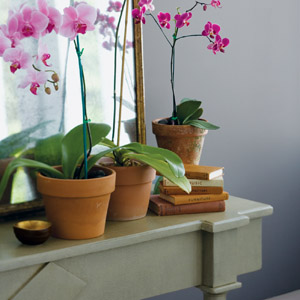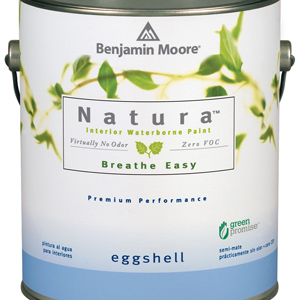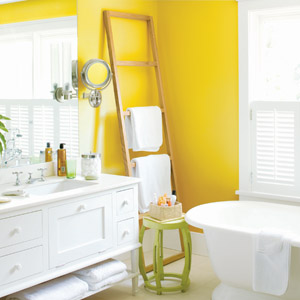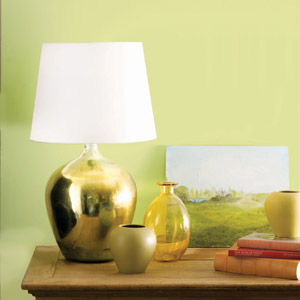 |

Not every surface is easy to reach. Extension poles make painting ceilings easier. Photo: Sherwin Williams

The overall trend right now in painted rooms is in matte finishes. Photo: Dior Gray by Benjamin Moore

Several companies now offer products that are low in volatile organic compounds (VOCs), and there are even zero-VOC products on the market now. Photo: Benjamin Moore

Typically, bathrooms, kitchens and other ‘wet’ areas need a higher sheen paint to lock out moisture and mildew. Photo: St. Elmo's Fire by Benjamin Moore

Take a look at the colors in a piece of art. Now look for the least-prominent color and hold that to the wall. See if you love that. Photo: Wales Green by Benjamin Moore
Take a look at the colors in a piece of art. Now look for the least-prominent color and hold that to the wall. See if you love that. Photo: Wales Green by Benjamin Moore
Your Basic Painting Toolkit
Every paint job is different, and each has its own needs. Here are the components of a good basic home interior painting kit that you should have on hand, says Jordan.
- Masking tape: For best results look for painter’s tape.
- Paint trays and liners: The plastic liners protect the tray from splatters and make it easy to clean up.
- Extension poles: Not every surface is easy to reach. Measure your ceiling height to get an idea of how much extension you’ll need. Extension poles make painting ceilings easier too.
- Spackle/wood putty: Essential for a good, smooth painting surface.
- Putty knives: Stiff putty knives are good for scraping rough patches, while the flexible counterparts are ideal for smoothing spackling paste.
- Sandpaper: Typically available in four basic grit sizes, sandpaper is a must for a good paint project.
- Caulk/caulk guns: Do you see a small crack beneath your window, or beside your door frame? You need a caulk gun and caulk to seal those areas.
-
From Flat to Gloss, Oil to Latex
Everything you need to know about interior paints.
- by Sam Gaines
You’re settled in your home. Maybe too settled. You want to liven up the interiors a bit, but have no idea what to do. May we suggest a fresh coat of paint? If you want to bring more color (or less, depending on what’s on your walls now) into your life, but you’re not sure where to start, read on.
What Hue Are You?
Embracing color is not as hard as you might think. Start with your color personality: What do you like? If you’re not sure, look around your home.
“Start with what you love,” says Sonu Mathew, Interior Designer-ASID, IIDA and senior interior designer with Benjamin Moore & Co. “Do you have a favorite artist, or something in your life that stirs your passion? Take a look at the colors of that piece of art. Now look for the least-prominent color and hold that to the wall. See if you love that.”
Begin with a single color, advises Jackie L. Jordan, director of color marketing for Sherwin-Williams—“and then develop color schemes around that hue by using the color wheel.” You can find an inexpensive color wheel at home improvement retailers, as well as art and craft stores.
Many people think in terms of shades of white for the sake of their homes’ resale value—or, at least, not shocking their loved ones. “If you are planning to paint for resale, neutral is always the best route to go,” says Jordan. “This doesn’t mean that everything should be stark white, but neutral off-whites with warm undertones are preferred.”
If you plan on staying awhile, though, put yourself first. “White is fine, but to me it’s a lost opportunity,” Mathew says. “Live your life! You have to express yourself in order to own your space. Not everyone chooses to do it with color on the wall, but it’s one of the easiest and most cost-effective ways to change your world to your liking.”
Remember, you can always repaint when it comes time to sell and move on.
A Primer on Paint
Interior house paints generally fall into two categories: latex- (acrylic) and oil/alkyd-based. Latex paints are the most common and oil-based paints are not as popular as they once were, in part because they’re more difficult to apply and require longer drying times.
“Today, most oil-based paints are made with synthetic resins (alkyds), which perform better than paints based on natural oils,” says Jordan. “Each type has different characteristics and uses. It’s a good idea to talk with your retail store paint expert to decide which paint is right for your project.”
To Shine or Not
To determine the sheen of the paint, think in terms of which rooms you’re painting. “Traditionally, when you’re thinking about room considerations, you’re thinking sheen levels,” Mathew says. “This is especially true of the bathroom, kitchen and other ‘wet’ areas. They need a higher sheen to lock out moisture and mildew.”
Sheen—the degree of a paint’s gloss—can vary from manufacturer to manufacturer, but mostly falls into types that range from no gloss to full gloss. Generally speaking, the higher the gloss, the deeper and more reflective (shinier) the color—but the more likely it is to show flaws in your wall. Here are the most common sheens in order of reflectivity:
- Flat: This type of paint has no gloss. New formulations in flat-sheen paints make it an increasingly popular choice for bedrooms and other lesser-traffic areas of the home. Today’s higher-end flat paints offer the low-sheen and durability often missing in the flat-sheen paints of the past. Flat paint is also the most common sheen used on interior walls by new home builders and contractors.
- Eggshell: As the name implies, this has a bit more sheen than flat paint and is a good all-around choice for walls.
- Satin: This “middle” choice also coats walls well and tends to be very durable.
- Semigloss: Very water-resistant as a rule, semigloss paints give a more luminous look to a wall and are a good choice for trim, too.
- Gloss: Full gloss—in a word, “shiny.” The most highly reflective finish, gloss paint will reveal defects in a wall (including brushstrokes) more readily.
Mathew points out that the overall trend is in matte finishes, and newer paint products allow for that even in “wet” rooms, such as the kitchen and bathroom.
And while you’re thinking paint, think primer. Why? “Primer helps seal the wall so it can accept the paint on its surface, rather than absorb it into the wall,” says Mathew.
“It’s the first step toward a lasting finish,” Jordan adds. “In general, the only time a primer is not needed is when you’re repainting a surface that’s in good condition.” Mathew agrees. “When in doubt, prime it out,” he adds.
Green: A Favorite “Color”
If you’re interested in painting green—and we’re not talking color—the options continue to grow, Consumers are more environmentally conscious than ever before, and that applies particularly to what we put in our homes. Paint is no exception. “What’s critical? Performance, aesthetics, and responsibility,” says Mathew. “You want a paint that is durable, that will cover and wear well, and is environmentally responsible.”
The good news is that paint manufacturers are going green. Several companies now offer products that are low in volatile organic compounds (VOCs), and there are even zero-VOC products on the market now.
But be careful about what you choose. Some paints bill themselves as zero-VOC, but don’t wind up that way when you take them home. “When you take it to the counter to have the color added, VOCs get added, as well,” Mathew says. “The government only regulates the VOCs that are in the bucket to start with.”
That’s why it’s wise to ask your paint retailer whether the tinting process adds VOCs to a zero-VOC product.

